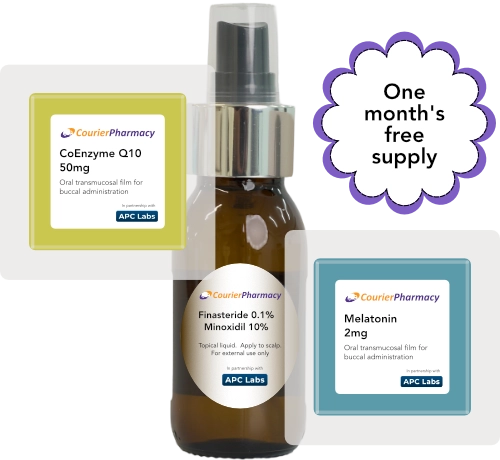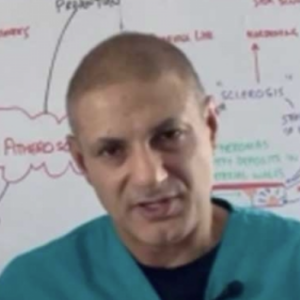Minoxidil is a popular treatment that both men and women use to tackle hereditary hair loss and boost hair regrowth. But how long does it take for minoxidil to work? In this blog, we’ll explore the timeline for minoxidil’s effects, breaking down the results you might notice once you start using it.
You can use the navigational table below to skip to the topics that interest you.
Table of contents
-
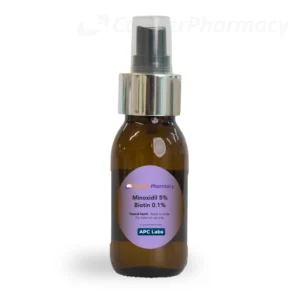 Minoxidil 5% Biotin 0.1% Topical Hair Loss Liquid£24.99
Minoxidil 5% Biotin 0.1% Topical Hair Loss Liquid£24.99 -
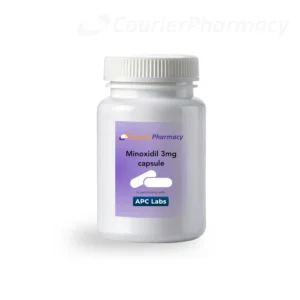 Minoxidil 3mg capsulesPrice range: £29.99 through £169.99
Minoxidil 3mg capsulesPrice range: £29.99 through £169.99 -
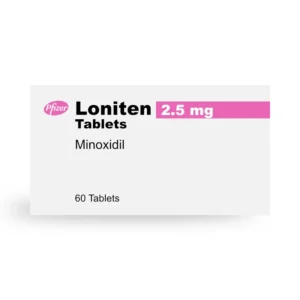 Loniten 2.5mg tablets (Minoxidil 2.5mg tablets)Price range: £39.99 through £99.99
Loniten 2.5mg tablets (Minoxidil 2.5mg tablets)Price range: £39.99 through £99.99
How long does it take for Minoxidil to work?
Short on time? Here’s a quick summary:
- Early signs: Most people notice changes within 8–12 weeks of regular use of minoxidil.
- Marked improvement: Around four months, many users see a clear reduction in hair loss.
- Visible regrowth: With daily application of minoxidil, it usually takes between 3 to 6 months to see obvious improvements in hair density and coverage.
- Temporary shedding: It’s normal to experience a brief increase in hair shedding when you first start using minoxidil, as more hair follicles move into the growth phase. This usually stops within about 2 months.
This guide breaks down the timeline for minoxidil’s effects and provides practical tips to help you achieve the best results.
Minoxidil and types of hair loss
Hair loss can occur due to a number of health issues. However the most common cause of hair loss in men is male pattern baldness or androgenetic alopecia [1]. This type of hair loss is associated with the classic receding hairline or thinning at the crown. If you start noticing hair loss in these areas, then its time to take action. The earlier you begin treatment with minoxidil, the more success you will see.
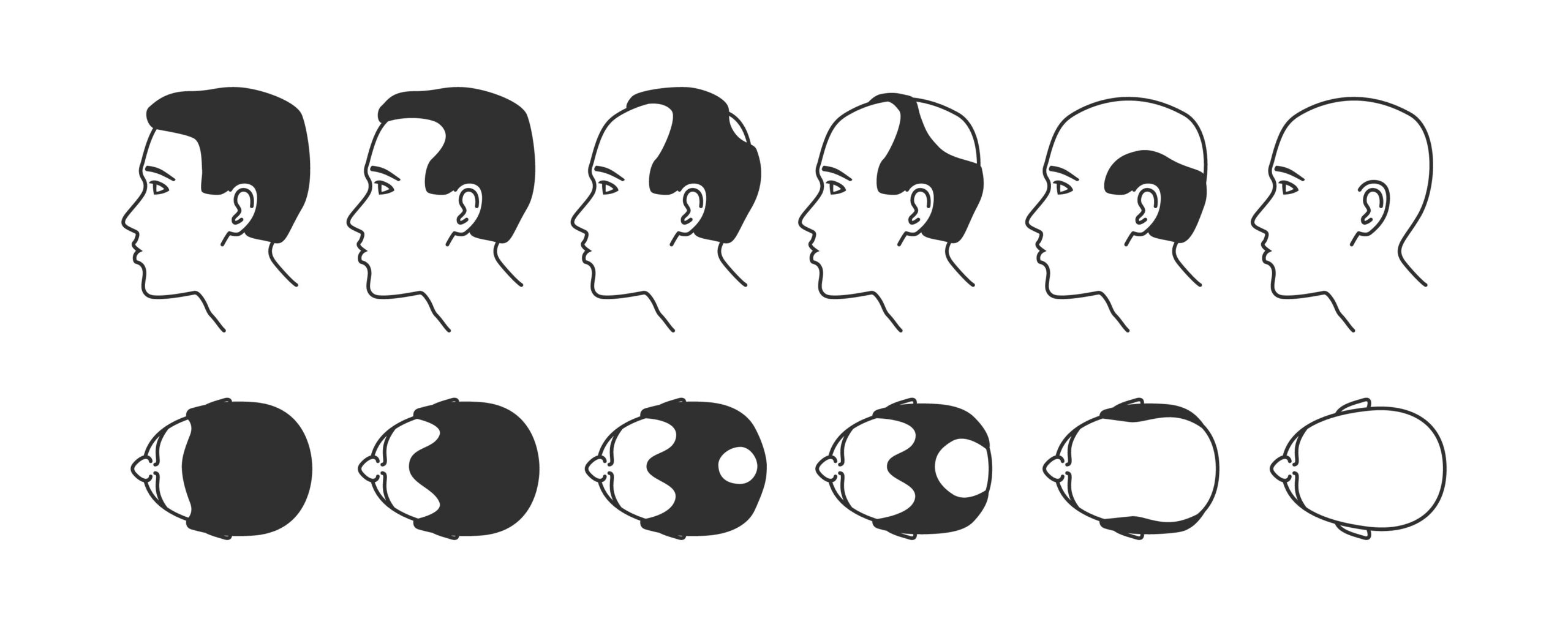
What causes male pattern baldness?
Androgenetic alopecia or male pattern baldness occurs due the actions of the hormone dihydrotestosterone or DHT on your hair follicle.
DHT is a made in your body as a byproduct or metabolite of testosterone. It attaches to receptors in your scalp, think of the DHT as a key and its receptor as a lock. When the DHT binds to its receptor in the scalp it opens the door to hair loss. It does this by causing your hair follicles to go through a process called miniaturisation [2].
What is hair miniaturisation?
This is when your hair follicles, under the influence of the hormone DHT, become miniaturised. The length of their growth phase or anagen phase shortens. This results in hair that is unable to grow properly.
This process of miniaturisation usually begins around your hairline and the scalp area. This leads to the classic receding hairline or bald patch at the top of your head.
How does minoxidil work?
Minoxidil works in a number of ways:
- Promotes hair growth: Minoxidil causes the hair follicles to shift from the telogen or resting phase of the hair growth cycle into the active growth or anagen phase [3].*
- Improves scalp circulation: It also increases blood flow to the scalp. This ensures that the growing hair follicles receive the nutrients they need to grow [4].
*If you want to learn more about the phases of hair growth, like the anagen phase, the telogen phase please read our blog, “The hair growth cycle”.
It’s important to note that these effects only occur as long as you’re using minoxidil. If you stop using the minoxidil, then the hair that was grown is lost within 12 to 24 weeks [5].
A good way to view minoxidil is to imagine a dry barren field. After a farmer applies some fertiliser and waters the land, life returns to the field and soon it is transformed into a field full of crops.
However, just like the farmer is not expecting to reap what he sows instantly, you should also expect hair growth to take some time. But how long does it take for minoxidil to work?
How long does it take minoxidil to work?
Minoxidil needs to be used daily to help improve hair growth and reduce hair loss. Most people begin to notice some improvement after about 4 months of consistent use, though visible regrowth can take between 3 and 6 months.
Significant hair regrowth—marked by increased hair thickness and better coverage—is often observed after 4 to 6 months. For maximum benefits, it may take up to a year of regular application.
Keep in mind that individual factors like genetics, age, and the extent of your hair loss will influence your results.
Even though minoxidil starts working in your body immediately, visible changes depend on the natural hair growth cycle. On average, hair grows about one inch per month. So you may need to wait several months after your hair enters the active growth phase before you see a noticeable difference.
Minoxidil and hair shedding
While minoxidil is generally well tolerated, one common side effect is a temporary increase in hair shedding. This often occurs when you first start treatment. This effect, often called “dread shed,” usually begins 2 to 4 weeks after you begin treatment and can last for 3 to 6 weeks [6].
Dread shedding happens because minoxidil shortens the resting phase of your hair cycle. This causes hairs that would normally fall out later to shed sooner [7]. This shedding is temporary and usually followed by thicker, fuller hair.
Studies have shown that this side effect is common, and sometimes it leads patients to stop their treatment [6].
So, if this happens to you when you start using minoxidil, don’t worry. This shedding is temporary and usually stops after about two months as the medication starts to stimulate new hair growth.
Minoxidil long -term results
When you use minoxidil regularly for 4-6 months, many people begin to notice new hair growth. Initially, you may see fine, soft hairs emerging, which will gradually thicken and become more robust. Typically, the most impressive results are achieved after about one year of consistent daily use.
Long term results of Minoxidil from clinical trials
Multiple clinical trials confirm that ongoing hair regrowth is achievable only through continuous daily use of minoxidil.
One 48-week study involving 393 men using the minoxidil 5% topical solution twice daily demonstrated sustained efficacy, with hair counts steadily increasing over time [8].
A 12-month study in Germany observed nearly 1,000 men with male pattern baldness using a 5% minoxidil solution applied twice daily [9].
Researchers found that 62% of the participants experienced a reduction in the balding area, 35% saw no change, and only 3% had an increase in hair loss. In terms of hair regrowth, 16% rated the treatment as very effective, 48% as effective, 21% as moderately effective, and 16% as ineffective [9].
Additionally, the average number of hairs lost during washing dropped from about 70 at the start to around 34 by the end of the study. Patient satisfaction improved, with scores rising from 2.9 to 4.4 on a scale of 0 to 10 [9].
Only 3.9% of patients reported side effects—mostly mild skin issues—with no serious adverse events recorded [9].
Factors affecting minoxidil results
The results that you will get from minoxidil will also depend on other factors such as genetics, age, overall health, and the extent of hair loss.
Those with mild to moderate hair loss tend to see the best outcomes, while individuals with more advanced hereditary hair loss may notice that minoxidil helps slow further thinning.
Genetics
Minoxidil doesn’t work the same for everyone. Many small genetic differences, called single nucleotide polymorphisms or SNPs, have been linked to male pattern hair loss or androgenetic alopecia [10] and how well treatments work.
For example, SNPs like rs13283456 (in the PTGES2 gene) and rs4343 (in the ACE gene) are connected to how our bodies widen blood vessels. Studies show that changes in these genes can play a part in developing hair loss [11].
Minoxidil works mainly by widening blood vessels. It does this by opening potassium channels in the smooth muscles of small arteries, which helps relax them. But this effect is not seen equally in everyone.
People with genetic variations that lower the activity of PTGES2 and ACE may see a better response to minoxidil, suggesting that your genes can influence how effective the treatment is [11].
Age
Age is also important; younger people with early hair thinning usually experience better outcomes than older individuals with more advanced loss.
Lifestyle
Additionally, your lifestyle matters. Eating a balanced diet, staying hydrated, managing stress, and avoiding smoking can all help improve your overall hair health and make minoxidil more effective.
Nutrition is key. Your hair is constantly growing and so needs a constant supply of raw materials. In fact, one of the side effects of the popular weight loss drug Mounjaro, is hair loss, which is experienced by about 5% of patients [12].
This is because Mounjaro suppresses the appetite which makes people eat less. As a consequence they do not take enough nutrients to keep their hair healthy.
In addition taking the right supplements, such as vitamin D and coenzyme Q10, will help ensure that you hair has all the necessary nutrients it needs to grow [12].
Pattern and extent of hair loss
Minoxidil works best for those with male or female pattern hair loss. It also works best if you have just started to notice your hair beginning to recede or if the bald patch on your scalp is still relatively small.
Typically, those with mild to moderate thinning notice more regrowth than those with severe hair loss. However, even if your hair loss is more advanced, using minoxidil consistently can help slow down further thinning.
Keeping your hair with minoxidil
The usual dose for topical minoxidil is to apply it twice daily while the oral minoxidil is taken once a day [7]. Results from clinical studies demonstrate that the best results are observed after prolonged use, typically after about one year [9].
However it’s important to remember, with minoxidil it’s a case of use it or lose it. The effects of minoxidil last only as long as you keep using it. If you stop using it, you will start losing that hair that was grown within 12 to 24 weeks [5].
What to do if minoxidil is not working?
If you haven’t started seeing some visible results within 3 to 6 months, it may be that genetically you are not suited for the type of minoxidil you are using. Recent research suggests that if the topical minoxidil is not giving you the results you would expect, it may be worthwhile switching to the oral tablets.
It has to do with the activity of an enzyme called sulfotransferase 1A1 (SULT1A1). If you have a lower activity of this enzyme, then the oral minoxidil tablets may be a better fit for you [13].
Adding other hair loss treatments
If you want to further increase your hair growth then you could start adding other active ingredients into the mix. This could include the DHT blockers such as finasteride and dutasteride.
At Courier Pharmacy we compound a wide range of combinations of topical minoxidil with either finasteride or dutasteride. If you don’t find a combination that you are looking for, or even if you would like to add other ingredients like biotin or coenzyme Q10, contact us. Our compounding team can come up with a topical preparation that’s right for you.
-
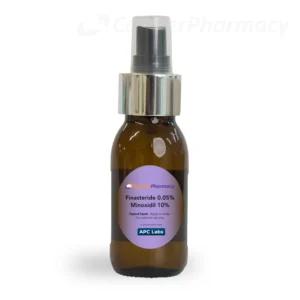 Finasteride 0.05% Minoxidil 10% Topical Hair Loss LiquidPrice range: £27.99 through £167.94
Finasteride 0.05% Minoxidil 10% Topical Hair Loss LiquidPrice range: £27.99 through £167.94 -
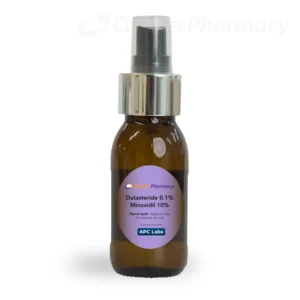 Dutasteride 0.1% Minoxidil 10% Topical Hair Loss LiquidPrice range: £34.99 through £199.99
Dutasteride 0.1% Minoxidil 10% Topical Hair Loss LiquidPrice range: £34.99 through £199.99 -
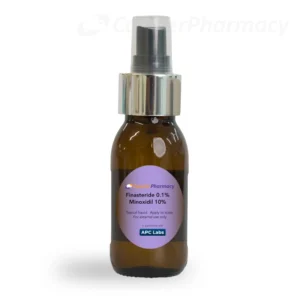 Finasteride 0.1% Minoxidil 10% Topical Hair Loss SolutionPrice range: £29.99 through £170.99
Finasteride 0.1% Minoxidil 10% Topical Hair Loss SolutionPrice range: £29.99 through £170.99
Hair loss and PRP
Platelet-Rich Plasma (PRP) therapy is an innovative treatment for hair loss that uses your own blood to encourage hair regrowth. In this procedure, a small blood sample is drawn and processed to concentrate the platelets, which are rich in growth factors.
These growth factors are then injected into the scalp to stimulate the hair follicles and promote natural hair regeneration.
Studies have shown that PRP can significantly increase hair count and thickness in patients with androgenetic alopecia [14].
Minoxidil side effects
In addition to confirming the safety of topical minoxidil, extensive research shows that side effects are uncommon. Possible side effects include:
- Seborrheic dermatitis
- Temporary hair shedding
- Scalp irritation or a burning sensation
- Pruritus (itchy, dry skin)
- Allergic reactions, such as contact dermatitis
In a study with over 900 men, fewer than 40 reported any adverse effects from using topical minoxidil. None of these side effects were considered serious [9].
Research also indicates that oral minoxidil is generally safe and effective for men with hair loss. However, though it should be used with caution in those with hypertension or heart problems [15].
Skin reactions with topical minoxidil
In rare cases, after several months of use, some individuals may develop allergic skin reactions [16].
If you find that after using the topical minoxidil liquid you develop mild irritation on their scalp, such as redness, or itching, it may a reaction to the propylene glycol within the topical liquid.
A simple solution would be to switch to the minoxidil foam preparation. Alternatively, you could try the oral minoxidil capsules or tablets.
Types of minoxidil
At Courier Pharmacy we offer a range of minoxidil formulations. Since we work with a compounding pharmacy we can compound the minoxidil into topical solutions, foams and capsules.
We can also add other active ingredients to the hair loss solutions, such as the DHT blockers finasteride and dutasteride.
-
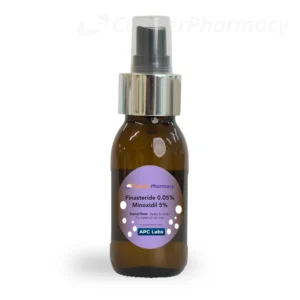 Finasteride 0.05% Minoxidil 5% Topical Hair Loss FoamPrice range: £30.99 through £185.94
Finasteride 0.05% Minoxidil 5% Topical Hair Loss FoamPrice range: £30.99 through £185.94 -
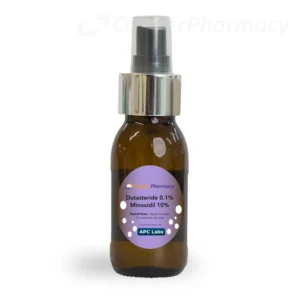 Dutasteride 0.1% Minoxidil 5% Topical Hair Loss FoamPrice range: £31.99 through £176.94
Dutasteride 0.1% Minoxidil 5% Topical Hair Loss FoamPrice range: £31.99 through £176.94 -
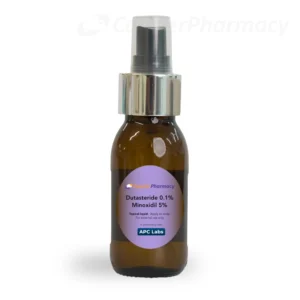 Dutasteride 0.1% Minoxidil 5% Topical Hair Loss LiquidPrice range: £31.99 through £180.95
Dutasteride 0.1% Minoxidil 5% Topical Hair Loss LiquidPrice range: £31.99 through £180.95
Minoxidil key tips for success
If you’re using minoxidil to fight male or female pattern hair loss, here are some tips to improve your results:
- Start now!: Begin treatment as soon as you notice signs of thinning hair. Early use is key to preventing further loss.
- Apply properly: Use the right amount and apply it evenly over your entire scalp—not just the thinning spots.
- Make it a habit: The benefits of minoxidil only continue as long as you use it regularly. Stopping treatment can lead to a return of hair loss and increased shedding. You don’t forget to brush your teeth because it has become an ingrained habit. Similarly make the application of minoxidil a habit.
- Combine active ingredients: Take advantage of our compounding pharmacy to combine different active ingredient, such as finasteride or dutasteride with minoxidil, in topical or oral formulations. This will lead to better results since you are blocking the miniaturisation effects of DHT with finasteride or dutasteride, while promoting hair growth with minoxidil. This allows you to attack hair loss from multiple angles.
- Try topical options: Applying topical solutions or foams means less active ingredients are absorbed systemically. This is particularly important if you are considering the DHT blockers finasteride or dutasteride. The topical options allow the active ingredients to absorbed locally where they are needed with less filtering into the systemic circulation [17].
- Avoid hair damaging habits: Just like you should adopt good habits, like remembering to apply your minoxidil, you should also avoid bad habits that can damage your hair. This includes not tying your hair too tightly, reducing excessive brushing, quitting smoking, and limiting exposure to harsh UV rays.
- Gradual improvement: Minoxidil can help boost hair growth and slow down hair loss. However, you’ll need to use it daily for about 4 to 6 months before seeing noticeable changes. It may take up to a year to achieve the best results.
- Initial shedding: It’s normal to experience a temporary increase in hair shedding during the first few weeks or months of treatment. This initial phase is a sign that the medication is stimulating new growth and typically subsides over time.
- Individual variations: Your results will depend on factors such as genetics, age, and the severity of your hair loss. Regularly check your progress with one of our prescribers with your FREE hair loss consultation.
- Be consistent: Remember the story of the tortoise and the hare? Well, be the tortoise, slow and steady wins the race. It’s a marathon not a sprint, so don’t expect to see instant results and keep applying the minoxidil daily.
- Eat an optimised hair growth diet: While no diet can completely stop hair loss, a nutritious diet rich in essential vitamins and minerals can enhance overall hair condition. Remember you want to provide your hair follicles with all the resources they need to produce thick, healthy hair.
Following these steps and sticking to a consistent routine will help maximise the benefits of minoxidil.
What to do next for hair loss?
Unsure of what steps to take next? Want some guidance on what combination products are best for hair loss? Please contact us for your FREE hair loss consultation.
Alternatively, if you know what you want then all you have to do is to follow these simple steps.
- Complete a short health questionnaire:
- Select Customised Treatments:
- Enjoy Fast, Confidential Delivery:
Minoxidil FAQs
How do I know if minoxidil is working?
It takes consistent daily use of minoxidil for at least 4 months before most people notice signs of improvement like decreased hair shedding and the beginnings of new regrowth. Taking comparison photos in the same light after a few months can highlight subtle changes. Give treatment at least 6 months before evaluating if it’s working for you.
When is it too late to use minoxidil?
It’s really never too late to try using Minoxidil properly to help manage your hair loss situation. Even people who have experienced significant balding tend to find consistent use of minoxidil helps slow or pause further hair thinning. Those in the early stages may see regrowth.
Does minoxidil thicken existing hair?
Yes, studies demonstrate that when used continually long-term, Minoxidil gradually enlarges miniaturised (shrunken) hair follicles. This leads to the production of noticeably fuller, thicker strands instead of fine, nearly invisible hairs. This beneficial thickening effect enhances the appearance of regrowth.
Can I take minoxidil with finasteride or dutasteride?
Yes you can! This way you can attack hair loss from multiple angles. The finasteride and dutasteride act as DHT blockers while the minoxidil acts as a vasodilator and promotes the growing phase of the hair.
Note: This information is for educational purposes only and should not substitute for professional medical advice.
References:
- Lolli, F., Pallotti, F., Rossi, A., Fortuna, M.C., Caro, G., Lenzi, A., Sansone, A. and Lombardo, F., 2017. Androgenetic alopecia: a review. Endocrine, 57, pp.9-17.
- Medical Mojo (n.d.) How does DHT cause hair loss? Available at: https://medicalmojo.co.uk/how-does-dht-cause-hair-loss/ (Accessed: 7 March 2025).
- Mori, O. and Uno, H., 1990. The effect of topical minoxidil on hair follicular cycles of rats. The Journal of dermatology, 17(5), pp.276-281.
- Shorter, K., Farjo, N.P., Picksley, S.M. and Randall1, V.A., 2008. Human hair follicles contain two forms of ATP?sensitive potassium channels, only one of which is sensitive to minoxidil. The FASEB Journal, 22(6), pp.1725-1736.
- Rossi, A., Cantisani, C., Melis, L., Iorio, A., Scali, E. and Calvieri, S., 2012. Minoxidil use in dermatology, side effects and recent patents. Recent patents on inflammation & allergy drug discovery, 6(2), pp.130-136.
- Nohria, A., Desai, D., Sikora, M., Mandal, S., Shapiro, J. and Sicco, K.L., 2024. Combating “dread shed”: The impact of overlapping topical and oral minoxidil on temporary hair shedding during oral minoxidil initiation. JAAD international, 15, pp.220-224.
- Patel, P., Nessel, T.A. and Kumar, D., 2023. Minoxidil. In statPearls [internet]. StatPearls Publishing.
- Olsen EA, Dunlap FE, Funicella T, Koperski JA, Swinehart JM, Tschen EH, Trancik RJ. A randomized clinical trial of 5% topical minoxidil versus 2% topical minoxidil and placebo in the treatment of androgenetic alopecia in men. J Am Acad Dermatol. 2002 Sep;47(3):377-85.
- Rundegren, J., 2004. A one-year observational study with minoxidil 5% solution in Germany: results of independent efficacy evaluation by physicians and patients 1. Journal of the American Academy of Dermatology, 50(3), p.P91.
- Heilmann, S., Kiefer, A.K., Fricker, N., Drichel, D., Hillmer, A.M., Herold, C., Tung, J.Y., Eriksson, N., Redler, S., Betz, R.C. and Li, R., 2013. Androgenetic alopecia: identification of four genetic risk loci and evidence for the contribution of WNT signaling to its etiology. Journal of Investigative Dermatology, 133(6), pp.1489-1496.
- Vila-Vecilla, L., Russo, V. and de Souza, G.T., 2024. Genomic Markers and Personalized Medicine in Androgenetic Alopecia: A Comprehensive Review. Cosmetics, 11(5), p.148.
- Medical Mojo (n.d.) Does Mounjaro cause hair loss? Available at: https://medicalmojo.co.uk/does-mounjaro-cause-hair-loss/ (Accessed: 7 March 2025).
- Jimenez Cauhe, J., Vaño Galvan, S., Mehta, N., Hermosa?Gelbard, A., Ortega?Quijano, D., Buendia?Castaño, D., Fernández?Nieto, D., Porriño?Bustamante, M., Saceda?Corralo, D., Pindado?Ortega, C. and Moreno?Arrones, O.M., 2024. Hair follicle sulfotransferase activity and effectiveness of oral minoxidil in androgenetic alopecia. Journal of Cosmetic Dermatology, 23(11), pp.3767-3773.
- Giordano, S., Romeo, M. and Lankinen, P., 2017. Platelet?rich plasma for androgenetic alopecia: does it work? Evidence from meta analysis. Journal of cosmetic dermatology, 16(3), pp.374-381.
- Panchaprateep R, Lueangarun S. Efficacy and Safety of Oral Minoxidil 5 mg Once Daily in the Treatment of Male Patients with Androgenetic Alopecia: An Open-Label and Global Photographic Assessment. Dermatol Ther (Heidelb). 2020 Dec;10(6):1345-1357.
- BinJadeed H, Almudimeegh AM, Alomran SA, Alshathry AH. A Case of Contact Allergic Dermatitis to Topical Minoxidil. Cureus. 2021 Jan 5;13(1):e12510.
- Medical Mojo (n.d.) How to reduce the side effects of Finasteride. Available at: https://medicalmojo.co.uk/how-to-reduce-the-side-effects-of-finasteride/ (Accessed: 7 March 2025).
Are weight loss treatments making you tired, or have they led to a sudden increase in hair loss? Do you struggle with sleep?
Get a free month’s supply of one of our compounded treatments for energy, hair loss or sleep, with your first purchase of Mounjaro or Wegovy from Courier Pharmacy.
Claim your FREE offer